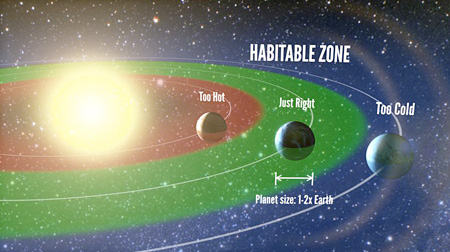Based on a statistical analysis of all the Kepler observations, astronomers at UC Berkeley and University of Hawaii, Manoa now estimate that one in five stars like the sun have planets about the size of Earth and a surface temperature conducive to life.
“When you look up at the thousands of stars in the night sky, the nearest sun-like star with an Earth-size planet in its habitable zone is probably only 12 light years away and can be seen with the naked eye. That is amazing” said UC Berkeley graduate student Erik Petigura, who led the analysis of the Kepler data.
The Kepler telescope photographed 150,000 of the 300 billion stars in the Milky Way for four years. The astronomers narrowed that number by focusing on just 42,000 stars like our sun or a bit cooler. That brought the number of planets down to 603. But only 10 of those were about the size of Earth in the so-called “Goldilocks zone”, just the right distance from the star where temperatures are suitable for life as we know it.

Using that data and computer models, the astronomers calculated that 22% of stars in the Milky Way similar to our sun have planets like Earth in their “Goldilocks zone”.
Earth-size planets in orbits about the size of Earth’s are not necessarily hospitable to life, even if they reside in the habitable zone around a star where the temperature is not too hot and not too cold. “Some may have thick atmospheres, making it so hot at the surface that DNA-like molecules would not survive. Others may have rocky surfaces that could harbor liquid water suitable for living organisms,” Marcy said. “We don’t know what range of planet types and their environments are suitable for life.”